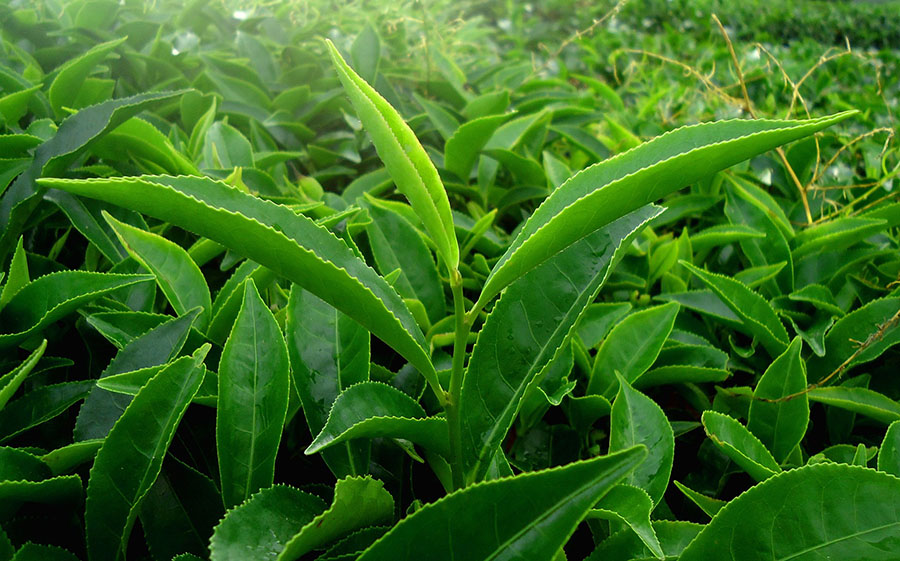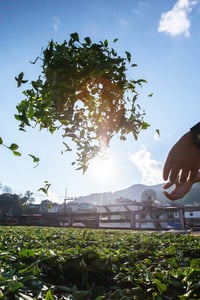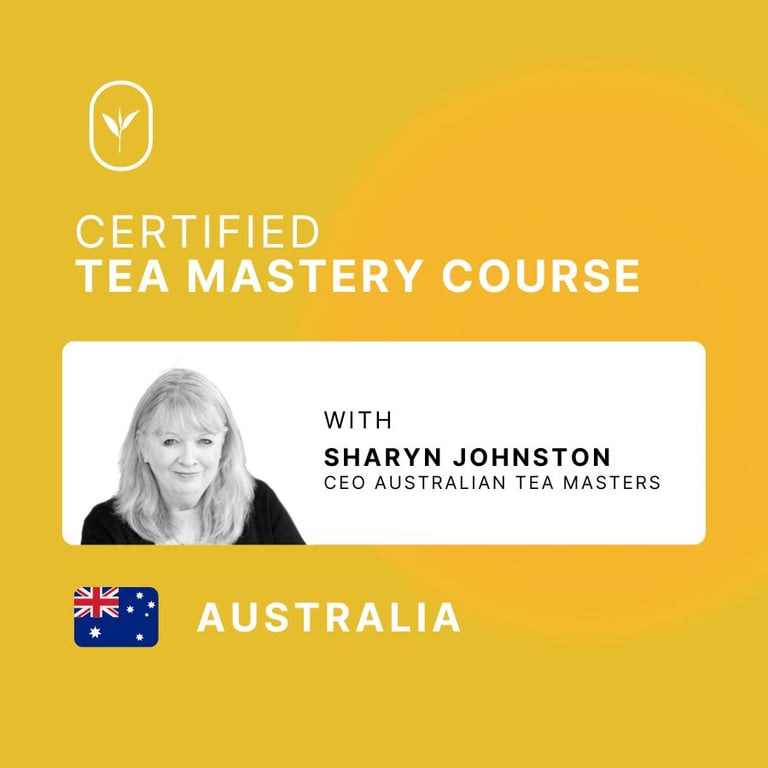Ever wondered about how you get from this:
To this?
It’s not magic, though at first glance it might seem like it. Tea processing is an ancient art that extends back thousands of years and begins in China. Through the millennia, the techniques for making it have become increasingly complex, specific, and refined.
Amazingly, nothing is added to the tea to create the finished product, and artisan specialty teas undergo some of the most interesting processing methods out there to showcase their magnificent flavours.
So, what are some of the techniques involved in making different teas?
- Plucking
- Withering (or Wilting)
- Bruising (or Disruption / Maceration)
- Fixation (or Kill-Green)
- Yellowing
- Shaping
- Drying
- Oxidising
In general, different types of tea are created by allowing the leaves to oxidise to a particular level. In green tea, the oxidation level might be as low as 15%, whereas a black tea usually carries the maximum amount of oxidation possible within the leaf, at 90-100%.
The above tea processing methods were developed to allow the tea to the correct level of oxidation while yielding particular shapes and flavours. Some processing skills create tea so unique by adjusting these methods it is not replicated anywhere else in the world.
Oxidisation occurs when heat is applied and the leaf cells break down. Now that you’re aware of oxidation and the purposes of processing, let’s explore what happens during each of these techniques.
Processing Techniques
Plucking
Tea processing begins with the act of picking the leaves, also known as plucking. This is generally done in the early springtime, but in some regions tea plants are harvested year-round. Hand-picking will produce a higher quality end-product, but some plants are still machine cut, usually due to high labour costs in a given producing country, for example in Australia.
Machine picking will be avoided, however, if the end goal is to produce the highest quality tea possible from the plantation, as it can cause leaf damage.
Skilled pluckers, many of whom have been picking tea for most of their lives and live on the tea estate, are capable of plucking up to 70 – 80 kilograms of tea on a good day. This tea will have been picked carefully from the stem, resulting in very little leaf breakage.
An alternative to machine picking and hand plucking is using hand shears, which allow for efficient harvesting. The cut tea leaves are often allowed to fall into a flexible bag held underneath. These shears offer more precise control over how the tea is cut than machine picking, but are still not as precise as picking the tea by hand.
Good plucking is the backbone of producing high quality tea before any other tea processing methods are employed.
Withering (or Wilting)
First, we may want the leaves to dry out and release their moisture content into the air, while encouraging oxidation. While tea leaves will begin to oxidise from the moment they are plucked, the process is very slow – withering speeds this up.
The leaves might be left out in the sun or in a warm breezy room, which helps them dry out, release their moisture, and break down the proteins inside, making the later processing methods they will undergo viable.
Varieties that use this tea processing method: White tea, oolong tea, black tea. Note that white tea does not undergo sun withering and is simply placed in a breezy room, which prevents oxidation from happening too quickly.
Bruising (or Disruption / Maceration)
After being withered, the leaves may be bruised to increase the level of oxidation further and release the leaf’s full flavour. This tea processing can be achieved by shaking the leaves in bamboo trays, tumbling them in baskets, or even by rolling, crushing, and tearing them by machine.
The enzymes inside the leaf will release and begin to combine, also affecting the end flavour in the cup. How the bruising is achieved and how much of it is done is individual to each tea.
Varieties that use this tea processing method: Oolong tea, black tea.
Fixation (or Kill-Green)
Once the tea is oxidised to the producers liking, the oxidation process needs to be stopped by the fixation process, or the tea would simply continue to oxidise (albeit at a slow rate). To do this, heat is applied to the leaves by steaming or panning them, which denatures the enzymes inside.
Because of this, the process is also sometimes referred to as de-enzyming.
Fixation is not usually necessary on black tea because the goal for most black teas is to achieve 100% oxidation. It is, however, an important step in tea processing in order to make all other types of tea.
Panning leaves is often done with no protective equipment on the hands and requires careful technique to avoid burning one’s fingers. Here’s what panning looks like in action:
Yellowing (or Sweltering)
This special tea processing technique is applied only to yellow teas, right after the fixation process has been completed. The leaves are warm and damp from fixation and are placed inside a container covered with a paper cloth, causing them to develop a distinct yellow colour over time.
This process also encourages the tea’s liquor to become yellow-green in the cup. It will give the tea a sweet mellow finish.
Shaping (or Rolling)
Once oxidised, or after yellowing in yellow tea, the damp leaves are shaped. This may be achieved either by rolling them or deliberately forming particular shapes – the exact technique will depend on what the finished tea is supposed to look like.
There are many different shapes the leaves can be encouraged into: coils, balls, cones, strips, twists, and pellets, to name a few. Typically when a machine is not involved, the tea will be rolled by placing the damp leaves in large cloth bags and kneading them by hand.
This process is performed on every type of tea to create a beautiful aesthetic (in artisan teas), or at least a shape with a certain amount of utility. The shape effects the end flavour.
Shaping has two main categorisations for its tea processing methods which produce very different qualities of tea:
Orthodox Method
In the orthodox processing method, the leaves are heavily rolled. This can be done either by hand on a rolling table, or by using a machine called a rotorvane.
The amount of rolling depends on the pressure which is applied from the top of the machine.
The rolling table on a rotorvane consists of a ridged tabletop that revolves underneath a large hopper of leaves. The leaves are pressed down into the revolving tabletop with hands and fingers.
This tea processing method produces a mixture of whole and broken leaves, as well as small tea particles, which are sorted, allowed to oxidise (if applicable), and dried.
Alternatively, the rotorvane machine consists of an auger which pushes withered leaves through a vane cylinder, crushing and cutting them evenly.
Rotorvanes can be mesmerising to watch in action.
CTC Method
CTC stands for Crush, Tear, Curl, and is a tea processing method that was developed by William McKercher in 1930. During the CTC process, machines cut and tear the leaves to produce tea which is often used in tea bags.
This method produces different grades of smaller leaf teas, and is almost never used for the production of high-quality specialty tea.
The CTC machine consists of a number of cylinder-shaped rollers, each bearing hundreds of sharpened teeth. A majority of tea produced today is finished using the CTC method instead of the orthodox method, as it is vastly cheaper and faster. This method is suitable for mass production.
Drying
In all teas except oolongs and puerhs (which can include an extra phase each), drying is done to finish the tea. There are a number of methods to do this, including leaving the leaves in the sun, heating them in a pan, drying them by air, or baking them.
Baking is the most common method used in this phase, but it is very important that producers are careful not to burn the leaves, as it can ruin an entire batch after so much work has already gone into it.
Curing or Fermenting
Oolongs are sometimes fired over charcoal and then somewhat aged in order to bring about the best flavours.
Puerhs, however, undergo fermentation. This fermentation process is done by a complicated and difficult process of ageing the tea in the ideal state of dampness. There are two types of puerh: sheng puerh, and shou puerh. While sheng puerhs are created often by appropriate ageing, shou puerh, which achieves the finished tea by cooking the leaves, allows puerh to be made quickly for consumers.
Sheng puerhs are frequently aged for many years, or even decades.
Okay, so now that we’ve looked at the main tea processing methods, how do these methods look on specific types of tea?
White Tea
White tea is the least processed type of tea and is produced using the youngest buds or leaves of the tea plant. Only minimal withering occurs before the oxidation process is halted by drying the leaves as quickly as possible.
As it has such minimal tea processing, white teas frequently possess some of the most delicate tastes of any tea type. Care must be taken when steeping not to burn the leaves.
Green Tea
In green tea processing, producers immediately steam or fire the fresh tea leaves, before drying them for preservation. As green tea requires much less oxidation than black tea, the oxidation process is stopped altogether by applying heat soon after picking. While Japanese producers will use steam to do this, traditionally Chinese producers cook the leaves in a hot pan.
During this process, the tea master controls the amount of heat and the time taken. Tea leaves are finally left to dry as loose tea, and are sometimes rolled tightly into balls. This produces what is known as a gunpowder-style green tea.
Green tea is processed within one to two days of harvesting, and variations in heat, rolling, and drying will impact its overall flavour.
The tea processing methods for creating green tea are thought to be the earliest created, making green tea the earliest known form of tea that remains popular today.
Yellow Tea
While yellow teas are often prized for their green style and sweet aftertaste, many are no longer being produced due to the length of time it takes to make them. The tea processing methods for these teas were originally created in China, but some were lost through the generations.
Scholars still travel the country in search of the missing yellow tea processing techniques, with the hopes of reviving teas that have since died out.
The sweltering or yellowing process is unique to yellow tea, and an essential part of its production. For those yellow teas that can still be made, additional tea processing techniques are applied, but these are usually family secrets unknown to outsiders. This makes the remaining yellow teas very special and unique. They are often considered delicacies by connoisseurs.
One thing’s for sure: the world is lucky to still possess a few of these ancient delicacies.
Oolong Tea
To make oolong tea, producers must stop oxidising the leaves some time before they become black tea, leaving them with an oxidation level that can vary widely — between 15% and 85%. This tea is partially oxidised and takes roughly three days to wither and dry.
Oolong, or ‘blue tea’, is predominantly made in Taiwan. The leaves are either tightly rolled into dense pellets, or dried in strips, which are known as strip oolongs. They can also be rolled to produce a spherical shape, which is known as a ball-rolled oolong.
Depending on their level of oxidation, oolong leaves can have deep chocolate browns and light greens, or even blue sheens. Sometimes the leaf will showcase different colours after steeping, in a beautiful display of the complexity of the tea processing methods it has been subjected to.
Black Tea
In black tea processing, producers usually allows the leaves to fully oxidise. First the leaves are withered to break down their compounds and reduce the overall moisture content. They then undergo maceration, which bruises them and allows the cells inside to release their enzymes. These enzymes are needed to fully oxidise and develop the leaf.
The large amount of oxidation of the leaf is what gives it such a dark colour. It also helps it to withstand very high water temperatures during steeping, often boiling or close to boiling.
Puerh Tea
When tea leaves are generously heated but not cooled quickly, they will begin to undergo a fermentation process, which is what produces puerh tea. To make puerh tea, the steamed tea leaves are pressed tightly into moulds. From here they are slowly dried into various shapes, where they continue to ferment.
Puerh cakes are usually made using mature, large, and whole tea leaves, sometimes stuck together with starch water, which can be extracted from cooked rice. An immense pressure is placed on the tea when forming the brick or cake into shape. It is then dried.
Producing tea in these brick-like cakes allows it to be stored and transported with ease, while in the meantime aging effectively.
There are two types of puerh — sheng puerh and shou puerh. Sheng puerh (raw puerh) is the more natural of the two, with a fermentation phase which can last up to and over 20 years. Older sheng puerhs which have been aged effectively can fetch startling amounts on the Chinese market, having become a collector’s item.
Shou puerh on the other hand, also known as ripe puerh, undergoes an accelerated fermentation phase in its tea processing strategy to produce a finished puerh cake in just a few months.
It is thought one of the original reasons puerh was pressed into cakes was to help it withstand long journeys on horse and cart. Tea would be taken throughout China in large quantities, but individual leaves were more easily blown away with the wind or accidentally tipped over cliff sides. Puerh cakes were very stable and had a set weight, making them ideal for trade.
Like champagne, the name “puerh” is geographically locked. True puerhs come only from Yunnan Province, China, though the tea processing techniques to make them have been replicated elsewhere.
 Tea processing is a specific and delicate process
Tea processing is a specific and delicate process
Getting the desired tea is an effort that takes many producers years to start getting right, especially if they are learning tea processing from scratch and aren’t part of a production family or working for an existing producer.
Experimentation is common and many new teas are made simply from varying the lengths of time specific tea processing methods are conducted.
Because of this, it’s even conceivable that some producers have created entirely novel tea processing techniques that aren’t even known outside their own factories; the world of tea is unbelievably vast and many farms and production facilities are very isolated. This is what makes visiting some of these facilities so exciting!
Are you looking to learn more about the world of tea?
This article was written based on an excerpt from our Tea Sommelier Handbook, and we’d be thrilled to share our knowledge with you. Pick up a copy here.













 Tea processing is a specific and delicate process
Tea processing is a specific and delicate process




